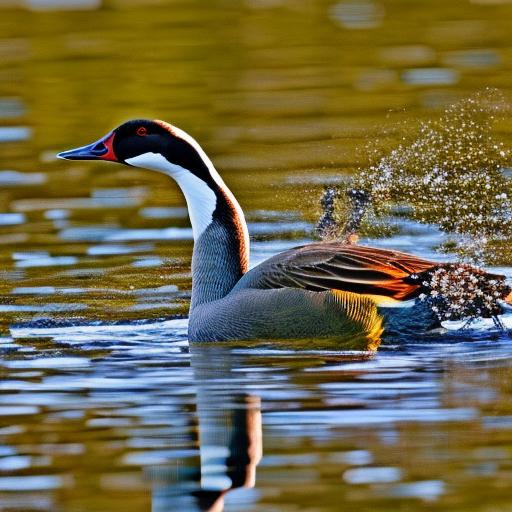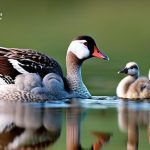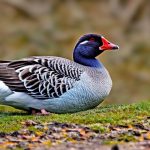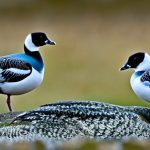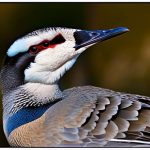Canada geese are a common sight in many parts of North America. Known for their distinctive honking call and V-shaped flying formation, these large waterfowl are a familiar sight in parks, golf courses, and other open spaces. While they may be beautiful to look at, Canada geese can also cause problems when their populations become too large. Managing Canada goose populations is important to prevent damage to property and landscaping, as well as to maintain a healthy balance in the ecosystem.
Key Takeaways
- Canada geese are social birds that mate for life and are highly adaptable to urban environments.
- Signs of a Canada goose infestation include large flocks, droppings, and damage to landscaping.
- Physical barriers such as fences and netting can be effective in keeping Canada geese out.
- Decoys, noise makers, and other scare tactics can be used to deter Canada geese from an area.
- Landscaping changes such as removing tall grass and adding prickly plants can discourage Canada geese from staying.
Understanding the behavior of Canada geese
To effectively manage Canada goose populations, it is important to understand their behavior. Canada geese are migratory birds, meaning they travel long distances between their breeding grounds in the north and their wintering grounds in the south. They typically follow the same migration routes year after year, returning to the same nesting sites each spring.
During the breeding season, Canada geese are known for their aggressive behavior. They will defend their nesting territory fiercely, often hissing and charging at intruders. Nesting pairs will build their nests near bodies of water, usually on elevated areas such as islands or beaver lodges. The female will lay a clutch of eggs and both parents will take turns incubating them until they hatch.
Canada geese are herbivores and feed primarily on grasses, grains, and aquatic plants. They will graze on lawns and fields, often leaving behind large amounts of droppings. Their feeding habits can cause damage to crops and landscaping, as well as create unsightly messes.
Identifying the signs of a Canada goose infestation
One of the first signs of a Canada goose infestation is the presence of large numbers of geese in one area. If you notice a large flock of geese congregating in a park or on a golf course, it may be an indication that their population is becoming too large.
Another sign of a Canada goose infestation is damage to property and landscaping. Geese can cause significant damage to lawns, golf courses, and agricultural fields by overgrazing and trampling vegetation. They can also damage property by nesting on rooftops or in other undesirable locations.
Feces accumulation is another telltale sign of a Canada goose infestation. Geese produce large amounts of droppings, which can create unsightly messes and pose health risks. The feces can also damage vegetation and contaminate water sources.
Creating a physical barrier to keep Canada geese out
One effective way to manage Canada goose populations is to create a physical barrier to keep them out of unwanted areas. There are several options for creating barriers, including fencing, netting, and landscaping modifications.
Fencing can be an effective way to keep geese out of specific areas. A tall fence with small openings can prevent geese from entering an area, while still allowing other wildlife to pass through. Electric fencing can also be used as a deterrent, as geese do not like the sensation of electric shocks.
Netting can be used to cover bodies of water or other areas where geese may congregate. The netting should be stretched tightly across the surface of the water or area to prevent geese from landing or swimming in it. This can be an effective way to keep geese away from swimming pools, ponds, or other water features.
Landscaping modifications can also help deter Canada geese. Planting tall grasses or shrubs around bodies of water can make it difficult for geese to access the area. Adding rocks or gravel to shoreline areas can also discourage geese from landing or nesting.
Using decoys and scare tactics to deter Canada geese
Another method for managing Canada goose populations is to use decoys and scare tactics to deter them from unwanted areas. Decoys can be placed in areas where geese are not wanted, such as lawns or golf courses. The decoys should be realistic and placed in groups to mimic the presence of other geese.
Noise-making devices can also be effective in deterring geese. These devices can include things like propane cannons, air horns, or even recorded goose distress calls. The loud noises and unfamiliar sounds can scare geese away from an area.
Visual deterrents can also be used to deter Canada geese. These can include things like scarecrows, reflective tape, or even predator decoys. The visual deterrents should be moved regularly to prevent geese from becoming accustomed to them.
Implementing landscaping changes to discourage Canada geese

Making changes to the landscaping can also help discourage Canada geese from staying in unwanted areas. Planting unappealing vegetation, such as prickly shrubs or tall grasses, can make an area less attractive to geese. Removing attractive features, such as open water or lush lawns, can also discourage geese from staying.
Adding deterrents like rocks or gravel to shoreline areas can make it difficult for geese to access the water. Geese prefer open areas where they have a clear line of sight, so adding obstacles like rocks or gravel can make an area less appealing to them.
Removing food sources to discourage Canada geese from staying
Canada geese are attracted to areas where there is an abundant food supply. By removing food sources, you can discourage geese from staying in unwanted areas. This can include cleaning up spilled food, removing bird feeders, and covering trash cans.
Cleaning up spilled food is important, as geese will often graze on leftover food scraps. This can include things like bread crumbs or spilled birdseed. By keeping the area clean and free of food debris, you can make it less attractive to geese.
Removing bird feeders can also help deter geese. Geese are attracted to bird feeders because they provide an easy source of food. By removing the feeders, you can eliminate this food source and discourage geese from staying in the area.
Covering trash cans can also help deter geese. Geese are attracted to garbage because it often contains food scraps. By keeping trash cans covered, you can prevent geese from accessing the food and discourage them from staying in the area.
Using repellents to keep Canada geese away
Repellents can be an effective way to keep Canada geese away from unwanted areas. There are several types of repellents available, including chemical repellents, natural repellents, and electronic repellents.
Chemical repellents can be applied to vegetation or other surfaces to make them unappealing to geese. These repellents typically have a strong odor or taste that is unpleasant to geese. They can be sprayed directly onto plants or applied to surfaces using a sprayer or paintbrush.
Natural repellents can also be effective in deterring Canada geese. These repellents use natural ingredients, such as garlic or hot pepper, to make an area unappealing to geese. They can be applied directly to plants or surfaces, or used in combination with other deterrents.
Electronic repellents use sound or light to deter Canada geese. These devices emit a high-pitched sound or flashing light that is unpleasant to geese. They can be placed in areas where geese are not wanted, such as lawns or golf courses.
Encouraging the use of natural predators to control Canada goose populations
One natural way to control Canada goose populations is to encourage the use of natural predators. Predators like coyotes or foxes can help keep goose populations in check by preying on eggs, young goslings, or even adult geese.
Introducing predators like coyotes or foxes can be an effective way to control Canada goose populations. These predators will naturally prey on geese and help keep their numbers in check. However, it is important to consider the potential impact on other wildlife and to ensure that the predators are not causing harm to humans or pets.
Encouraging natural predators like hawks or eagles can also help control Canada goose populations. These birds of prey will hunt and feed on geese, helping to keep their numbers in check. By providing suitable habitat and nesting sites for these predators, you can encourage them to stay in the area and help control the goose population.
Seeking professional help for Canada goose removal and management
In some cases, it may be necessary to seek professional help for Canada goose removal and management. This is especially true if the infestation is large or if other methods have been unsuccessful.
When deciding to call in a professional, it is important to choose a reputable company. Look for a company that has experience in Canada goose removal and management, as well as the necessary permits and licenses. They should also use humane methods that comply with federal and state laws.
Understanding the legal regulations surrounding Canada goose control
It is important to understand the legal regulations surrounding Canada goose control. Canada geese are protected under federal and state laws, so it is important to ensure that any control methods used are legal and humane.
Federal laws protect migratory birds, including Canada geese, under the Migratory Bird Treaty Act. This law makes it illegal to harm or kill migratory birds without a permit. It is important to consult with local authorities or wildlife agencies to ensure that any control methods used comply with federal laws.
State laws may also regulate the control of Canada geese. These laws can vary from state to state, so it is important to familiarize yourself with the specific regulations in your area. Permits or licenses may be required for certain control methods, such as trapping or hunting.
Humane treatment guidelines should also be followed when managing Canada goose populations. This includes using methods that do not cause unnecessary harm or suffering to the geese. It is important to choose control methods that are effective, but also considerate of the welfare of the geese.
Managing Canada goose populations is important to prevent damage to property and landscaping, as well as to maintain a healthy balance in the ecosystem. Understanding the behavior of Canada geese and identifying the signs of an infestation are key to effective management. Creating physical barriers, using decoys and scare tactics, implementing landscaping changes, removing food sources, using repellents, encouraging natural predators, seeking professional help, and understanding legal regulations are all strategies that can be used to manage Canada goose populations. It is important to use responsible and humane control methods to ensure the well-being of the geese and maintain a healthy environment.
If you’re looking for ways to keep Canada geese off your property, you might also be interested in learning about effective strategies for maintaining a chicken coop. Poultry Wizard offers a helpful article on how to build and maintain a chicken coop in Chester, SC. By implementing the right techniques and using appropriate materials, you can create a secure and comfortable environment for your chickens while keeping unwanted visitors like Canada geese at bay. Check out the article here for valuable insights on protecting your property and ensuring the safety of your poultry.
FAQs
What are Canada geese?
Canada geese are large water birds that are native to North America. They are known for their distinctive black heads and necks, white cheeks, and brown bodies.
Why do Canada geese come onto my property?
Canada geese are attracted to properties that have open water, grassy areas, and easy access to food. They may also be attracted to properties that are near their natural habitats, such as lakes, rivers, and wetlands.
What problems can Canada geese cause on my property?
Canada geese can cause a number of problems on your property, including damage to landscaping, contamination of water sources, and aggressive behavior towards humans and pets. They can also be noisy and messy, leaving behind droppings and feathers.
What are some ways to keep Canada geese off my property?
There are several ways to keep Canada geese off your property, including installing physical barriers like fences or netting, using visual deterrents like scarecrows or reflective tape, and using noise deterrents like loudspeakers or air horns. You can also make your property less attractive to geese by removing sources of food and water.
Is it legal to harm or kill Canada geese?
No, it is not legal to harm or kill Canada geese without a permit from the appropriate wildlife agency. Canada geese are protected under the Migratory Bird Treaty Act, which prohibits the hunting, killing, or possession of migratory birds without a permit.
Meet Walter, the feathered-friend fanatic of Florida! Nestled in the sunshine state, Walter struts through life with his feathered companions, clucking his way to happiness. With a coop that’s fancier than a five-star hotel, he’s the Don Juan of the chicken world. When he’s not teaching his hens to do the cha-cha, you’ll find him in a heated debate with his prized rooster, Sir Clucks-a-Lot. Walter’s poultry passion is no yolk; he’s the sunny-side-up guy you never knew you needed in your flock of friends!

